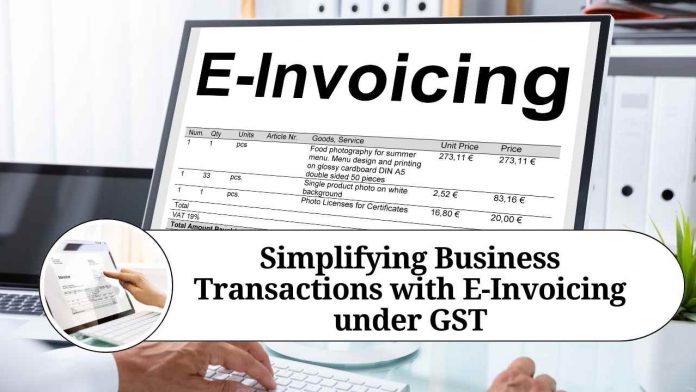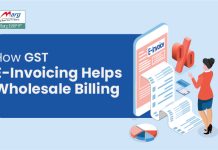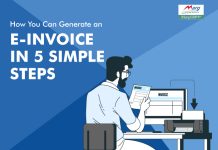Introduction
The Goods and Services Tax (GST) has revolutionized the taxation system in India, streamlining processes and eliminating various complexities associated with indirect taxes. One of the notable advancements in this regard is the implementation of e-invoicing. E-invoicing refers to the electronic generation of invoices, which are authenticated by the GST Network (GSTN). This blog aims to provide a comprehensive understanding of e-invoicing under GST and how it simplifies business transactions.
What is E-Invoicing under GST?
E-invoicing is a digital mechanism for generating, validating, and reporting invoices directly to the GSTN. It involves the transmission of invoice data in a standardized electronic format, ensuring accuracy, authenticity, and interoperability across different accounting systems. E-invoicing eliminates the need for physical invoices and manual data entry, leading to reduced errors and enhanced efficiency in business transactions.
Benefits of E-Invoicing:
- Streamlined Compliance: E-invoicing automates the process of invoice generation, ensuring compliance with GST regulations. It helps businesses avoid errors, such as incorrect tax calculations or mismatched invoice details, which can lead to penalties or delays in tax refunds.
- Faster Processing: With e-invoicing, invoices are generated electronically, reducing the time and effort required for manual data entry. This accelerates invoice processing, facilitates quicker payments, and improves cash flow management for both businesses and their customers.
- Enhanced Data Accuracy: Manual data entry is prone to human errors, which can have significant consequences for businesses. E-invoicing eliminates these errors by automating the data transfer process, resulting in accurate and reliable invoice information.
- Real-time Tracking: E-invoices are uploaded to the GSTN in real time, allowing businesses to track the status of their invoices throughout the supply chain. This transparency enables timely reconciliation and ensures smooth operations between suppliers and recipients.
- Cost and Resource Savings: Adopting e-invoicing eliminates the need for physical storage and manual processing of paper invoices. This not only reduces costs associated with printing, storage, and logistics but also frees up valuable human resources for more productive tasks.
- Seamless Integration: E-invoicing can be seamlessly integrated with accounting and ERP systems, enabling businesses to automate their entire invoice processing workflow. This integration streamlines operations, minimizes manual intervention, and improves overall productivity.
- Data Analytics and Insights: The digitization of invoices allows businesses to gather valuable data, which can be utilized for in-depth analytics and decision-making. By analyzing invoice patterns and trends, businesses can gain insights into customer behavior, optimize pricing strategies, and improve operational efficiency.
E-Invoicing Implementation and Compliance:
E-invoicing has been implemented in a phased manner, starting with businesses with a turnover exceeding a specified threshold. It requires businesses to generate invoices in a standardized format (e.g., JSON) and authenticate them using a digital signature or QR code. The authenticated e-invoices are then uploaded to the GSTN for validation and subsequent sharing with recipients.
To ensure compliance, businesses need to stay updated with the latest e-invoicing regulations, including any changes or updates introduced by the GSTN. They should also ensure the integration of their invoicing systems with the GSTN’s e-invoicing portal or adopt third-party solutions that comply with the prescribed standards.
Conclusion
E-invoicing under GST has emerged as a game-changer for businesses in India. It has transformed traditional invoice generation processes, bringing efficiency, accuracy, and transparency to business transactions. By adopting e-invoicing, businesses can simplify compliance, streamline operations, reduce costs, and gain valuable insights.
Read more useful content:
Frequently Asked Questions (FAQs)
Q1: What is e-invoicing under GST?
A1: E-invoicing under GST refers to the generation, validation, and reporting of invoices in a standardized electronic format. It involves the transmission of invoice data directly to the GST Network (GSTN) for authentication, ensuring accuracy, authenticity, and interoperability.
Q2: Who is required to implement e-invoicing under GST?
A2: Initially, e-invoicing was mandated for businesses with an annual turnover exceeding a specified threshold. However, the turnover threshold and applicability may vary, so it’s essential to refer to the latest notifications and updates issued by the government.
Q3: How does e-invoicing simplify compliance?
A3: E-invoicing simplifies compliance by automating the invoice generation process, reducing the likelihood of errors and ensuring adherence to GST regulations. It eliminates issues like incorrect tax calculations or mismatched invoice details, which can lead to penalties or delays in tax refunds.
Q4: What are the benefits of implementing e-invoicing under GST?
A4: The benefits of e-invoicing include streamlined compliance, faster processing, enhanced data accuracy, real-time tracking, cost and resource savings, seamless integration with accounting systems, and the ability to gather data for analytics and insights.
Q5: How can businesses integrate e-invoicing with their existing systems?
A5: Businesses can integrate e-invoicing with their existing systems by either adopting accounting and ERP solutions that are already compliant with the GSTN’s e-invoicing requirements or by leveraging third-party solutions that facilitate seamless integration.
Q6: What is the process of e-invoicing under GST?
A6: The process of e-invoicing involves generating invoices in a standardized electronic format (such as JSON), authenticating them using a digital signature or QR code, and uploading them to the GSTN for validation. The authenticated e-invoices are then shared with the recipients.
Q7: How does e-invoicing help in tracking invoices?
A7: E-invoicing allows businesses to track the status of their invoices in real time. By uploading invoices to the GSTN, businesses can monitor the progress of invoices throughout the supply chain, enabling timely reconciliation and facilitating smooth operations.
Q8: What are the compliance requirements for e-invoicing under GST?
A8: To comply with e-invoicing regulations, businesses need to generate invoices in the prescribed format, authenticate them with a digital signature or QR code, and upload them to the GSTN. They must also stay updated with the latest guidelines and any changes introduced by the GSTN.
Q9: Can businesses use third-party solutions for e-invoicing under GST?
A9: Yes, businesses can choose to use third-party solutions that comply with the prescribed e-invoicing standards. These solutions can help streamline the e-invoicing process, integrate with existing systems, and ensure compliance with GST regulations.
Q10: Is e-invoicing mandatory for all businesses under GST?
A10: Initially, e-invoicing was mandated for businesses above a certain turnover threshold. However, the applicability may vary, and the government can update the thresholds or extend it to more businesses in the future. It is essential to stay informed about the latest notifications issued by the authorities.




















